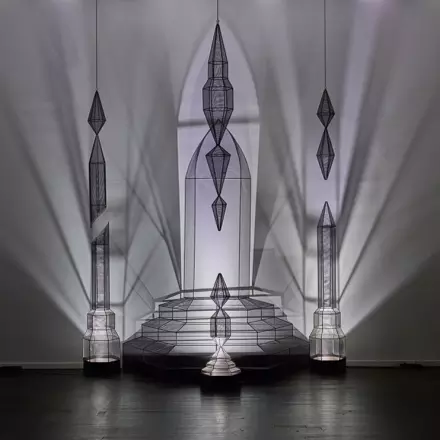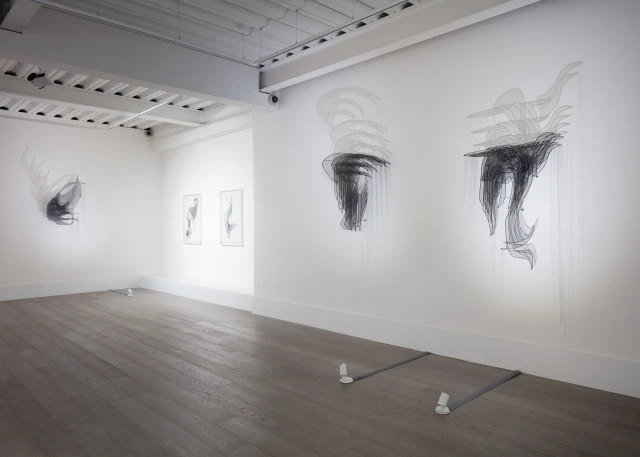Sophia Contemporary is pleased to announce Echo’s Chamber, the first solo exhibition of Iranian-American artist Afruz Amighi in the UK. The exhibition – which also marks Amighi’s first solo show with Sophia Contemporary following her successful inclusion in the gallery’s group show ‘Shifting Landscapes’ earlier this year – will feature nine new sculptures made from the artist’s signature combination of steel, chain, and mesh illuminated by light, along with eight drawings. Spurred by the continued struggle for women’s liberation as well as by the current sociopolitical climate in both the USA where she resides and in her native Middle East, Amighi’s new works explore ideas of femininity through a series of female archetypes from history as well as the artist’s personal experience. Echo’s Chamber will open to the public with a talk by the artist from 6-7PM on Thursday, November 23, 2017 followed by a Private View from 7-9PM. The exhibition will remain on view through January 19, 2018.
Afruz Amighi’s delicate abstract sculptures refer to a complex array of architectural sources: the meandering arabesques of Islamic mosques, the angular shapes of Gothic churches, the ornamentation of Manhattan Art Deco buildings and the urban landscape of Brooklyn, among others. Architecture in its various expressions is a medium for Amighi to investigate the way in which humans across cultures and ages build structures which reflect common ideals and aesthetic values in spite of the complexity and precariousness of society. With these sources in mind, Amighi welds common materials such as steel, chain, and mesh into delicate wall sculptures that belie the strength of their industrial components. When illuminated, the sculptures create a wall of shadows, reflecting and magnifying the intricate patterns in a play of light and dark on the walls.
The exhibition’s title embodies this reflective “echo” while also recalling the Greek myth of Echo and Narcissus. Amighi is interested in the contradictory nature of Echo being used as a symbol of womankind: while Echo can only repeat what is being said by others, her voice is nonetheless heard repeatedly and endlessly… it cannot be silenced. With this exhibition, Amighi figuratively provides Echo with a chamber, giving her more agency through the possession of a space of her own. Through the use of this universal myth as a conceptual and symbolic referential point, Amighi explores the nature and perception of womanhood while actively advocating for the greater inclusion of female voices in art history and contemporary debates.
Echo’s Chamber marks both a continuation and departure from the artist’s earlier sculptural work. Using a similar technique to her previous architecture-based sculptures, Amighi produces meticulous drawings on Mylar paper before rendering them in three-dimensions. While reminiscent of the abstraction of her earlier work, each of Amighi’s new sculptures represents a female form drawn from different regions and periods of world history. Following recent political events and especially the US election, Amighi’s practice became at once more personal and more political. Responding to the hypermasculinity of the current environment, the sculptures in Echo’s Chamber explore themes of femininity, the qualities of heroines in both mythology and contemporary society, as well as historic and current examples of matriarchal systems in order to articulate the dynamics, similarities and contradictions in the experience of women.
The works in Echo’s Chamber also reflect on the politics of representation in the institutional world. The aesthetics of the sculptures and drawings in the exhibition are inspired in part by recent visits the artist made to the atrium of the Metropolitan Museum of Art, which houses the collection of Greek and Roman sculptures, and to the Museum’s ‘Arts of Africa, Oceania and the Americas’ wing, which includes many sculptures and ritual masks. The elegance and regal presence of female figures in the African section and more particularly the boldness of the 19th century wooden sculpture ‘Mende Helmet Mask’ constituted important sources of inspiration for the artist. Similarly, the graceful way in which the Greeks and Romans depicted folds of clothing in marble inspired the artist’s approach to her new works.
During her visits, however, Amighi was struck by the fact that the Greek and Roman sculptures were housed in a windowed hall bathed in sunlight while African art was displayed in a dimly lit, low-ceilinged wing of the Museum. This contrast, and its implied socio-political and cultural implications, created an urge for the artist to bring elements from both those regions and periods of art history together in new works that would manipulate light in a different way. The artist’s fantasy of reversing the situation by placing works of the African wing in the atrium and GrecoRoman sculptures in the dimly lit room led her to openly question the implicit hierarchies of institutional representation and remedy such historical imbalance through her own work. By drawing her inspiration from a wide array of historical and cultural sources, both Western and non-Western, and reshaping and restaging their presentation, Amighi investigates the socio-political and cultural implications of curating museum collections while advocating for a contemporary reassessment of the role of non-Western cultures in art history.
Amighi draws on a wide range of sources: historic texts and Ancient Greek sculpture, medieval European art, Persian architecture, Native American arts and crafts, African art, and the Carnival of New Orleans, among others. Amazon (2017) is inspired in part by Amighi’s fascination with an Ancient Greek sculpture titled The Wounded Amazon in the collection of the Metropolitan Museum of Art, a larger-than-life sculpture of a woman with her arm drawn back and one of her breasts revealed. The figure does not show any visible wounds and appears fierce and defiant despite the title. In Amighi’s hands, the Amazonian figure becomes even more mysterious, cast in an elusive position that defies a simple narrative.
The Nun (2017) is reflective of Amighi’s desire to explore the realm of ‘feminine seclusion’: the nun, the anchoress, the female hermit… This realm represents a space for European women who, for various reasons, were not negotiated into the domestic realm through marriage. Although becoming a nun was rarely a choice, the convent was nonetheless an all-female zone, a place where women existed in some sort of sisterhood and which in some cases could be used spiritually to channel a degree of agency. As in the artist’s other sculptures and drawings, The Nun is depicted with a large knife-like object piercing through her body. These knives are symbols of oppression and violence inflected on women by society as well as by the self. By using such a powerful symbol, Amighi strives to create realistic versions of women in which both their agency and their oppression exist side by side. The women in the artist’s new works are neither fearless mythological Amazons, nor bereaved victims, but rather real women who contain both dynamics within.
Echo’s Chamber will be accompanied by a fully illustrated catalogue to be published in conjunction with the exhibition’s opening.
About Afruz Amighi
Afruz Amighi (born 1974, Iran) is a sculptor and installation artist based in Brooklyn, New York. Amighi’s celebrated sculptural wall pieces composed of industrial materials are influenced by the art and architecture of her home country. In 2009, she was the inaugural recipient of the Jameel Prize for Middle Eastern Contemporary Art, awarded by the Victoria & Albert Museum in London for work inspired by Islamic traditions. In 2011, she was granted a fellowship in sculpture by the New York Foundation for the Arts. In 2013, her work was commissioned for the 55th Venice Biennale. In the summer of 2018, the Frist Center for Visual Arts in Nashville, Tennessee will present the first major museum exhibition of her work.
Amighi’s work is included in the collections of the Metropolitan Museum of Art, NYC, USA; the Houston Museum of Fine Art, TX, USA; the Cleveland Museum of Art, OH, USA; the Victoria & Albert Museum, London, UK and the Devi Foundation, New Delhi, India, among others. Amighi’s work has been exhibited in the United States, Europe, and Asia. The artist completed her BA in political science at Barnard College at Columbia University and her MFA at New York University.
 Afruz Amighi
Afruz Amighi 